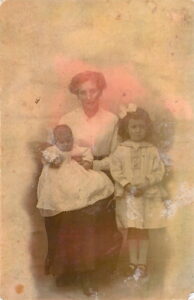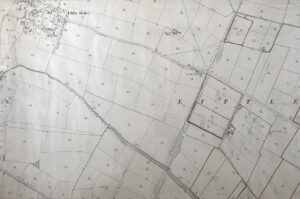Clogs, cloaks and soot on the lung: this year, Adelle Stripe found family history buried in a shoebox in the shed.

Following my father’s unexpected crossing of the River Styx in early summer, and the unsettling excavation of thirty years’ worth of newspapers, bills, broken objects and tinned food from his house, I came across a series of photographs buried beneath piles of mouse droppings in his garden shed. These were the belongings of my beloved Nana Meg, which were left to him more than a decade ago and had been there ever since.
The images, almost sepia since their development in the early part of the 20th century, had names written on the back in her distinctive handwriting – some taken of distant family members in studios, others on seaside holidays, or in back gardens, wearing new clothes. Unlike today’s disposable digital imagery, photographs were a luxury back then, often taken to mark an occasion. Diane Arbus once said, ‘A picture is a secret about a secret, the more it tells you the less you know.’ I wondered what I could interpret from these collected snapshots that had miraculously been preserved in the cold and damp – and were now beginning to fade.
Looking at the faces, I could almost remember who these people were, and how we were related, a distant memory from quiet Sundays perched on the sofa, leafing through her quilted photo albums and imagining life in the olden days. There was little else to do in the sleepy town where I spent my formative years. Daydreaming of times past became a way to cope with boredom, and the slow tick of the carriage clock placed on the mantelpiece. Nana Meg’s living room was adorned with gleaming net curtains, brassware (polished weekly), and a large copper rendering of Constable’s The Haywain. My imagination is still transported back to that calm environment, and the stories she told at bedtime about who we were and where we came from.
After packing up her photographs into a crate, I attempted to make a list of who was related to who and note down what Dad had told me over the years (his memory was excellent until the very end), but still, there were large holes in the family tree that I could not recall. Instead of spending endless hours in the windowless room of grief, I vanished down the rabbit hole of genealogy, piecing together the roots of our ancestral history online and connecting them with piles of random photographs laid out on my office floor. It was a strange hobby that was all-consuming and rarely provided answers, only more questions. Census details, birth and death certificates, military records, even school and burial ground entries came to light. There were many surprises, and numerous tragedies. But what really leapt out from this mass of information, was the lack of status of women in our family. Many were from agricultural families, who barely moved from nondescript hamlets around Lincolnshire, often bearing ten children and losing half as many. These were women with no occupations as such, other than being officially recorded as domestic servants. Presumably, pre-19th century, they were illiterate, too. Enormous families resided in two-bedroom worker’s houses that would be uninhabitable in the modern age. But behind what was written in ink, these formidable women were midwives, healers, seamstresses, even vigilantes. Men worked down the pits (Featherstone, Durham and Barnsley collieries), in the fields, or on the railways, and one, miraculously, at the Ministry of Ungentlemanly Warfare. Many died young from industrial injuries – decapitations, immolation, or soot on the lung. Some were lost in great storms at sea. Or spent their miserable childhoods at Ragged Trouser schools. Others became shopkeepers, bakers and confectioners. In comparison, the women’s stories are barely acknowledged and exist only by what has been passed down by our female relatives, an oral history, word of mouth.
For a few months, establishing what happened to great great gran Fanny Johnson became a regular pursuit. Even with my historical researcher’s cap on, I could not unearth what happened to her, and how/where she died, at the age of 43. Her file remained blank on the page. All I really knew came from the notes left by Meg in a small shoebox many years ago. According to her own mother, Fanny’s son had died aged 13 under the wheels of horse wagon in the Fens, she was so traumatised by the event that she lost her mind and was found wading through the beck wearing only her nightshirt in the small hours. After that, Fanny was banished to a nearby asylum and never returned. Unable to raise his children alone, her husband employed a helper, who he eventually married. The helper stole the family’s linen (the only thing of value they owned) and became a full-time inebriate. In true Dickensian style, the children were sent to a workhouse, where they likely lived on a diet of gruel and stale bread.
Thankfully, I have decided not to pursue the life of Fanny Johnson as my next novel, the cloak and clogs melodrama that nobody needs to read, but I am glad to have spent some time thinking about her life, and the village of Little Hale, a place I have never visited aside from a sedated crawl on Google Maps. I am convinced this tool is one of the greatest inventions for any writer. There is no limit to how many hours you can waste meandering through streets and random dead-ends.

It’s not all depressing of course, my grandfather’s family were wealthy in comparison and even owned a fancy bakery on Portobello Rd, and the flat above, overlooking Ladbroke Grove. It has been enlightening to find out the addresses of distant relatives, the various lives they lived, and piece together the jigsaw. The past is infinitely more comforting than the present. I prefer to spend most of my time there. All fiction must start somewhere, and perhaps, as Elizabeth McCracken writes in The Hero of this Book, ‘Your family is the first novel that you know.’
What I have learned from this year’s exhausting pursuit is that the gaps are always where curiosity leads. Nobody cares about this genealogical information aside from some of your closest relatives. And your own mind’s eye will always seek the most dramatic interpretation of events. You chase thrills from the evidence, creating narratives that aren’t necessarily true, for the sake of entertainment. And even though they are easy to discard, photographs always have some intrinsic value. I have started the slow process of backing each image up from discarded albums in my father’s garden shed — hundreds of small square shots, some backed on cardboard, others so faint they have almost bleached out — in the hope our ancestors will never fade from view.